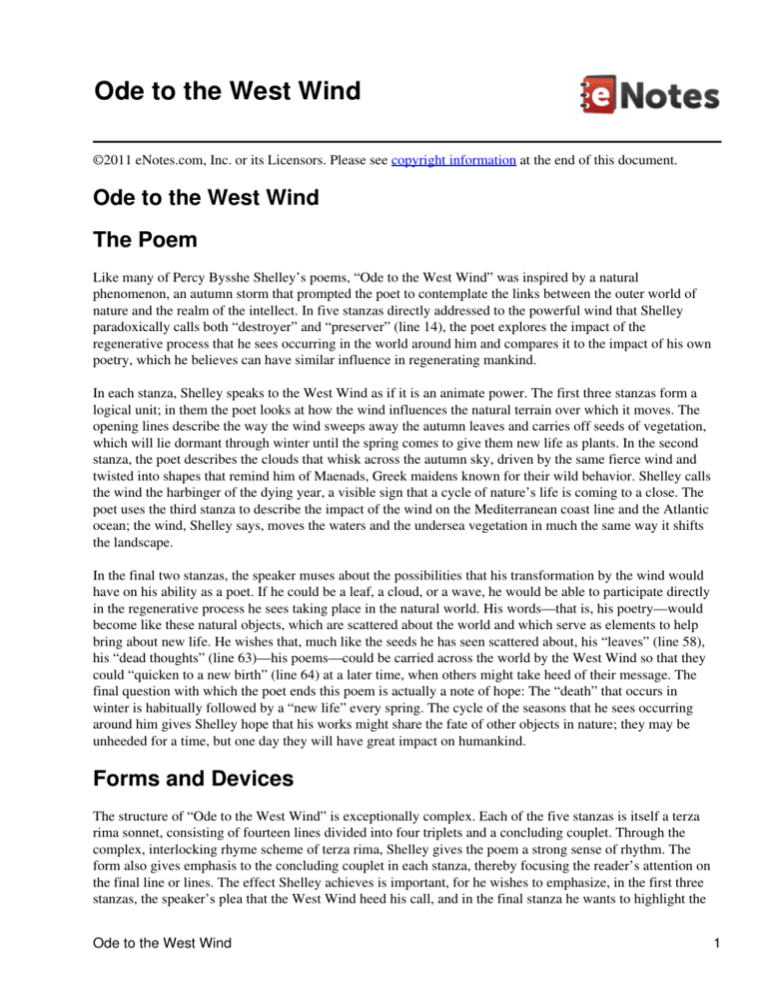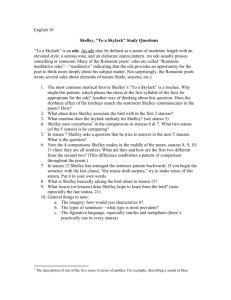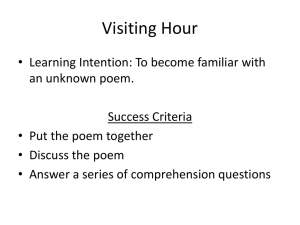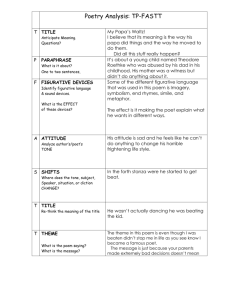
Ode to the West Wind
©2011 eNotes.com, Inc. or its Licensors. Please see copyright information at the end of this document.
Ode to the West Wind
The Poem
Like many of Percy Bysshe Shelley’s poems, “Ode to the West Wind” was inspired by a natural
phenomenon, an autumn storm that prompted the poet to contemplate the links between the outer world of
nature and the realm of the intellect. In five stanzas directly addressed to the powerful wind that Shelley
paradoxically calls both “destroyer” and “preserver” (line 14), the poet explores the impact of the
regenerative process that he sees occurring in the world around him and compares it to the impact of his own
poetry, which he believes can have similar influence in regenerating mankind.
In each stanza, Shelley speaks to the West Wind as if it is an animate power. The first three stanzas form a
logical unit; in them the poet looks at how the wind influences the natural terrain over which it moves. The
opening lines describe the way the wind sweeps away the autumn leaves and carries off seeds of vegetation,
which will lie dormant through winter until the spring comes to give them new life as plants. In the second
stanza, the poet describes the clouds that whisk across the autumn sky, driven by the same fierce wind and
twisted into shapes that remind him of Maenads, Greek maidens known for their wild behavior. Shelley calls
the wind the harbinger of the dying year, a visible sign that a cycle of nature’s life is coming to a close. The
poet uses the third stanza to describe the impact of the wind on the Mediterranean coast line and the Atlantic
ocean; the wind, Shelley says, moves the waters and the undersea vegetation in much the same way it shifts
the landscape.
In the final two stanzas, the speaker muses about the possibilities that his transformation by the wind would
have on his ability as a poet. If he could be a leaf, a cloud, or a wave, he would be able to participate directly
in the regenerative process he sees taking place in the natural world. His words—that is, his poetry—would
become like these natural objects, which are scattered about the world and which serve as elements to help
bring about new life. He wishes that, much like the seeds he has seen scattered about, his “leaves” (line 58),
his “dead thoughts” (line 63)—his poems—could be carried across the world by the West Wind so that they
could “quicken to a new birth” (line 64) at a later time, when others might take heed of their message. The
final question with which the poet ends this poem is actually a note of hope: The “death” that occurs in
winter is habitually followed by a “new life” every spring. The cycle of the seasons that he sees occurring
around him gives Shelley hope that his works might share the fate of other objects in nature; they may be
unheeded for a time, but one day they will have great impact on humankind.
Forms and Devices
The structure of “Ode to the West Wind” is exceptionally complex. Each of the five stanzas is itself a terza
rima sonnet, consisting of fourteen lines divided into four triplets and a concluding couplet. Through the
complex, interlocking rhyme scheme of terza rima, Shelley gives the poem a strong sense of rhythm. The
form also gives emphasis to the concluding couplet in each stanza, thereby focusing the reader’s attention on
the final line or lines. The effect Shelley achieves is important, for he wishes to emphasize, in the first three
stanzas, the speaker’s plea that the West Wind heed his call, and in the final stanza he wants to highlight the
Ode to the West Wind
1
significant rhetorical question with which the poem ends.
The primary literary trope in the poem is personification. Shelley repeatedly addresses the West Wind as if it
were an animate, intelligent being; one might be reminded of the way elements of nature are represented in
classical Greek or Latin literature, or in American Indian writings. Shelley wants readers to consider the Wind
a living force that helps shape the landscape—literally, the physical landscape, and metaphorically, the
landscape of human minds and attitudes.
Shelley uses three major images of the poem—the wave, the leaf, and the cloud—to demonstrate the ways in
which the West Wind treats elements of the physical landscape. The poet’s scene-painting is especially
noteworthy; in a few short lines in each of the first three stanzas he depicts the effects of the fierce autumn
wind on the ocean, the earth, and the sky. In the fourth stanza, he applies these descriptions to himself, calling
on the West Wind to work its magic on him in the same way it has on the natural world, so he too will “die”
only to rise again and give life—intellectual life.
One of the most striking images in the poem is used in the fourth stanza to describe the poet’s present plight:
“I fall upon the thorns of life! I bleed!” (line 54) he cries out to the West Wind. In that single line, following
his plea that he be made like the wave, the leaf, or the cloud so he can be transformed by the powers of the
wind, Shelley expresses the problem of the Romantic poet: He would soar to new heights of understanding
and deliver insight into life to all humanity if he could, but his human nature keeps him affixed to the earth,
with all its troubles and stumbling blocks. Life itself is seen as a painful rosebush whose thorns afflict one
who wishes to rise above the day-to-day humdrum of human existence. Shelley realizes that he cannot do so.
Nevertheless, he has hopes that his works may be like those natural objects that seem to die in winter only to
rise to new life in spring. He compares his verse to “ashes and sparks” from an unextinguished fire (line 67),
which he hopes the wind will scatter so they may flare up in other places, thereby widening his impact on
others.
Themes and Meanings
In “Ode to the West Wind,” Shelley examines and compares two phenomena that are particularly potent: the
power of nature and the power of poetry. Like most Romantic poets, he sees a clear link between these two,
believing that the poet’s power arises from nature, inspired by it and akin to it in many respects. Many
similes in this poem, and in others by Shelley, focus readers’ attention on the comparisons. Donald Reiman
has described the themes of this poem as “the Poet’s personal despair and his hopes for social renewal”
expressed “in images drawn from the seasonal cycle” (Percy Bysshe Shelley, 1969). Hence, the destructive
power of the West Wind parallels Shelley’s fear that the beauty of the natural world, and metaphorically the
beauty of his own works, is doomed to oblivion by a hostile and insensitive force. At the same time, however,
he recognizes that the destructive power of the West Wind is but a part of a larger cycle in which what seems
like death is merely a necessary stage in the process of regeneration that perpetuates life itself. In the final
stanzas of the poem he offers some hope that, despite his being constricted by his humanity and possibly
being ignored by those whom he wishes to enlighten, he may one day be able to speak to others. Like the new
life that comes inevitably every spring, his works may be “reborn” when people (perhaps those other than his
contemporaries) discover them and listen to Shelley’s calls for social and moral reform.
The specifics of Shelley’s plan for reforming the world do not appear in “Ode to the West Wind.” Rather,
this poem focuses on the process by which his other works may one day achieve their purpose in the world.
Those familar with classical or Renaissance poetry may notice a similarity between this poem and those by
Horace or by Ben Jonson, whose “Go, Little Book” verses appeal in a similar way for the continued life of
their poetry. Like those poets who preceded him, Shelley hopes that his work will one day be read and
appreciated by an audience that can understand his deep concern for the improvement of humankind, one that
Forms and Devices
2
will be willing to listen to his plan for bringing about such improvement.
Copyright Notice
©2011 eNotes.com, Inc.
ALL RIGHTS RESERVED.
No part of this work covered by the copyright hereon may be reproduced or used in any form or by any means
graphic, electronic, or mechanical, including photocopying, recording, taping, Web distribution or information
storage retrieval systems without the written permission of the publisher.
For complete copyright information, please see the online version of this work:
http://www.enotes.com/ode-west-wind-salem
Themes and Meanings
3








